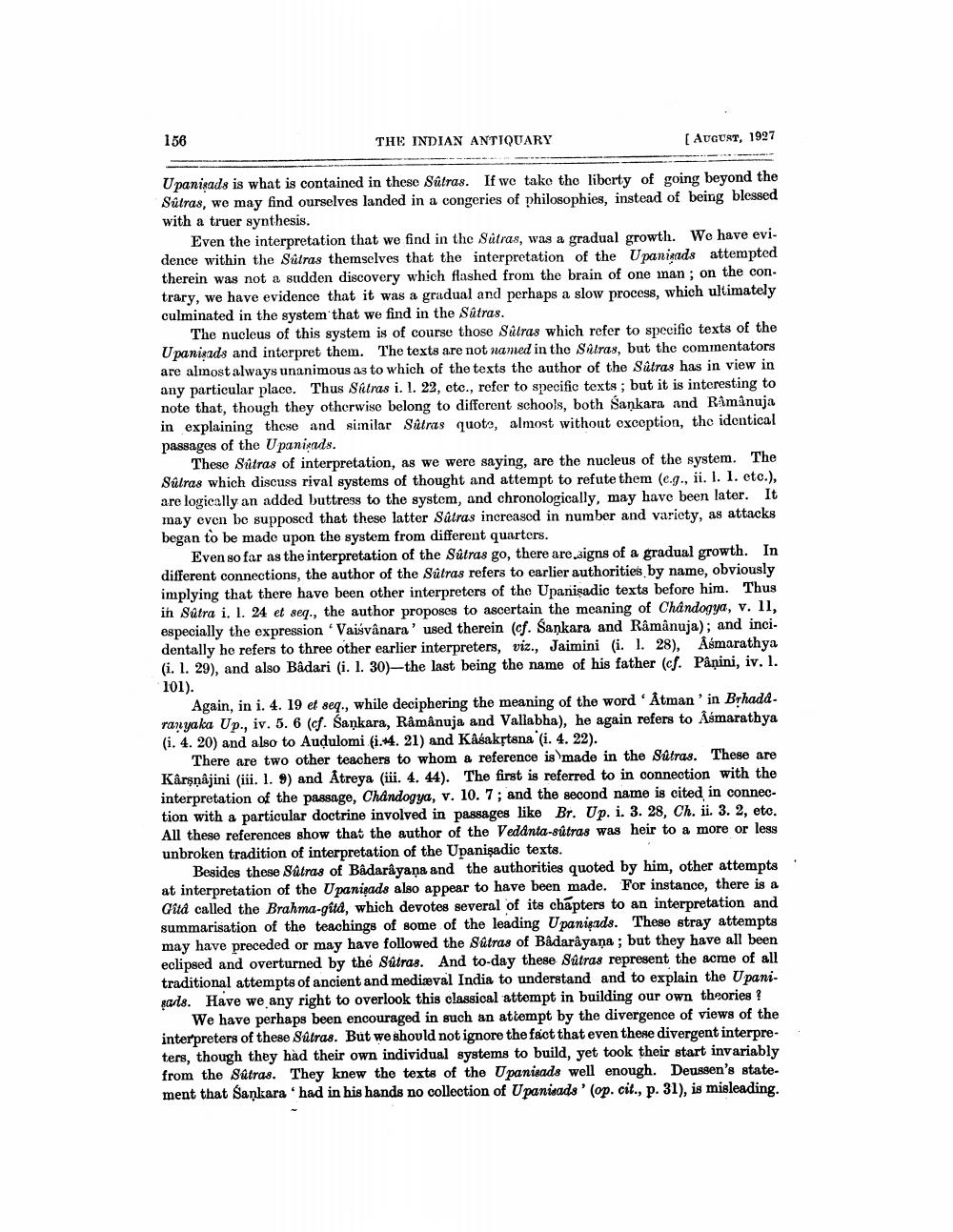________________
156
THE INDIAN ANTIQUARY
[ AUGUST, 1927
Upanisads is what is contained in these Sûtras. If we take the liberty of going beyond the Sútras, we may find ourselves landed in a congeries of philosophies, instead of being blessed with a truer synthesis.
Even the interpretation that we find in the Sätras, was a gradual growth. We have evidence within the Sútras themselves that the interpretation of the Upanigads attempted therein was not a sudden discovery which flashed from the brain of one man ; on the con. trary, we have evidence that it was a gradual and perhaps a slow process, which ultimately culminated in the system that we find in the Sûtras.
The nucleus of this system is of course those Súlras which refer to specific texts of the Upanišads and interpret them. The texts are not named in the Satras, but the commentators are almost always unanimous as to which of the texts the author of the Satras has in view in any particular place. Thus Satras i. 1. 22, etc., refer to specific texts; but it is interesting to note that, though they otherwise belong to different schools, both Sankara and Ramanuja in explaining these and similar Satras quots, almost without exception, the identical passages of the Upanisads.
These Sútras of interpretation, as we were saying, are the nucleus of the system. The Súlras which discuss rival systems of thought and attempt to refute them (e.g., ii. 1. 1. etc.), are logically an added buttress to the system, and chronologically, may have been later. It may even be supposed that these latter Sätras increased in number and variety, as attacks began to be made upon the system from different quarters.
Even so far as the interpretation of the Sútras go, there are signs of a gradual growth. In different connections, the author of the Sutras refers to earlier authorities by name, obviously implying that there have been other interpreters of the Upanişadic texts before him. Thus in Sutra i. I. 24 et seq., the author proposes to ascertain the meaning of Chandogya, v. 11, especially the expression 'Vaiývânara' used therein (cf. Sankara and Ramanuja); and inci. dentally he refers to three other earlier interpreters, viz., Jaimini (i. 1. 28), Åsmarathya (i. 1. 29), and also Bådari (i. 1. 30)—the last being the name of his father (cf. Påņini, iv. 1. 101).
Again, in i. 4. 19 et seq., while deciphering the meaning of the word 'Åtman'in Brhadaranyaka Up., iv. 5. 6 (cf. Sankara, Ramanuja and Vallabha), he again refers to Asmarathya (i. 4. 20) and also to Audulomi (i.4. 21) and Kasakstana (i. 4. 22).
There are two other teachers to whom a reference is made in the Sûtras. These are Kârşņajini (iii. 1. 9) and Åtreya (iii. 4. 44). The first is referred to in connection with the interpretation of the passage, Chandogya, v. 10. 7; and the second name is cited in connection with a particular doctrine involved in passages like Br. Up. i. 3. 28, Ch. ii. 3. 2, eto. All these references show that the author of the Vedanta-sútras was heir to a more or less unbroken tradition of interpretation of the Upanişadic texts.
Besides these Satras of Bådarayana and the authorities quoted by him, other attempts . at interpretation of the Upanigads also appear to have been made. For instance, there is a Cità called the Brahma-gitd, which devoted several of its chapters to an interpretation and summarisation of the teachings of some of the leading Upanişads. These stray attempts may have preceded or may have followed the Sûtras of Bådarayaņa ; but they have all been eclipsed and overturned by the Sútras. And to-day these Sútras represent the acme of all traditional attempts of ancient and mediæval India to understand and to explain the Upanişarls. Have we any right to overlook this classical attempt in building our own theories?
We have perhaps been encouraged in such an attempt by the divergence of views of the interpreters of these Sutras. But we should not ignore the fact that even these divergent interpreters, though they had their own individual systems to build, yet took their start invariably from the Satras. They knew the texts of the Upanieads well enough. Deussen's statement that Sankara'had in his hands no collection of Upanisads' (op. cit., p. 31), is misleading.




